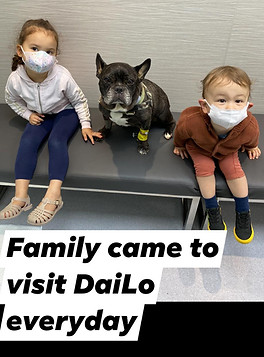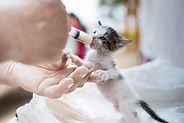

Case 1-Amber
SUCCESSFUL DENTAL PROCEDURE FOR A dog with SEVERE TEETH PROBLEM AND HIGH ANAESTHETIC RISK


Amber is a 12 years old Poodle, who has diabetes, heart disease, hypothyroidism, trachea collapse, chronic bronchitis and proteinuria. Because she has so many diseases, previous vets all told the owner she was not suitable for any procedure that requires anesthesia. Her dedicated mum who has been taking the excellent care of her, always believe she is suffering from teeth problem as Amber had teeth chattering frequently but other vet thought she has jaw joint problem.
Since no other vets were willing to do the anesthesia, dental examination and treatment for Amber. They came to me for second opinion.
On the examination, it was clearly she had periodontal disease and need a proper treatment. In order to ensure the anesthesia has the lowest risk, I did the heart ultrasound for her and her heart condition was very stable. The blood test results were great for her age and condition. Amber has been coughing for years which the owner thought it was not treatable. The chest radiograph showed that she has evidence of chronic bronchitis but never been told and never been treated. After trial treatment the coughing was much reduced and 2 weeks later, Amber finally got her teeth treated.
Because her teeth problem were pretty bad, there were 24 teeth extracted. The owner was very touched afterwards because Amber’s teeth chattering has immediately resolved and became a lot happier and eats a lot.
We’d like to share this case because we often feel sad that many pet owners are told their pets are not treatable, or sometimes the vets overemphasized the risk which pushes the owner away from the treatment the animals need.
Anesthetic risk is a common concern, however it can be lowered by careful monitoring, performing pre-anesthetic tests and appropriate anesthetic plan.
Case 2-LUNA
EYELID LUMP REMOVAL SURGERYIN DOGS
Luna is a 13 years old poodle, her owner noted the lump since a while ago. Even thought she had laser removal twice in other clinics, the lump still growing back each time. The lump was previously diagnosed as a benign mass. They decided to come to us for surgical removal.
As you can see in the photo, 2 weeks after surgery the wound already healed and it shouldn’t grow back at the same site.
Even the nodule is not a malignant mass, it can still grow and causing problem. Most common cause is meibomian gland adenoma.
Since the mass is growing from the eyelid gland, removing the base of the mass with part of the eyelid is the only curative way, otherwise it will still grow back like two surgery Luna had before.






Case 3-DAILO
LIVER DISEASE
IMMUNE-MEDIATED HEPATITIS
DaiLo is a 8 year old French Bulldog who came in 2 weeks ago because he had been vomiting every 1-2 days and vomited more frequently before coming to us.
He had history of swallowing foreign objects. The owner was a bit worried it might be another accident.
On examination DaiLo’s skin and eye looked a bit yellow, the blood test showed severely elevated liver parameters ( over 15x of normal) and jaundice index( i.e total bilirubin, normally less than 15, his was 182, indicated something going on in the liver/ gallbladder system.
We did ultrasound scanning for DaiLo, there was no foreign object in the stomach and intestine. The liver/gallbladder looked fine on ultrasound.
The initial differential diagnosis including, intoxication, liver/gallbladder bacteria infection
acute hepatitis (inflammation in the liver)
Since bacteria infection in the liver/gallbladder is a common cause,antibiotic trial was started and DaiLo was also admitted into hospital because he was quite sick.
We monitor the jaundice index (total bilirubin everyday) and it gradually went up over 213 on the third day
His skin and eyes also became more and more yellow and he remained ill
Because he was not responding to liver support treatment and antibiotic.
Dr Ryan decided to use steroid strategically.
Using steroid is often terrifying to pet owner and many vets.
Without correct diagnosis and experience, it can often be harmful to the dogs
however for hepatitis( inflammatory disease of the liver), steroid is the only drug which can save the dogs
Dr Ryan used a testing dose on the first day, DaiLo apparently became brighter and his appetite improved the next day
Total bilirubin remains same level at 215, which means the worsening has slowed down
Since it looked like we are in the right direction, we increased the dose further and the next day he improved significantly and total bilirubin dropped 50% from 215 to 105 within 24 hours
There are several possible causes for acute onset of increased liver parameter,
1. Intoxication
2. Liver/gallbladder infection
3. Immune mediated hepatitis(inflammation)
4. Neoplasia(cancer)
Liver biopsy is often needed to confirm the diagnosis.
However in many acute serious situation like DaiLo, it is often not practical as the dogs’ condition are often not be suitable to go through surgery.
So vet should often try treatment based on his or her assessment and experience.
The reason we shared this case is to show everyone how steroid for immune mediated hepatitis can dramatically improve the condition. But there are a few points you should be aware of too.
Without a diagnosis, steroid SHOULD NEVER be the FIRST treatment to try for liver disease unless other causes are ruled out and immune mediated hepatitis is suspected.
Using steroid can be harmful if
THE INDICATION IS NOT ACCURATE, or if the animal is HAVING ONGOING INFECTION
THE DOSE IS NOT ACCURATE:
the dose of the steroid can be quite variable:
When dose is too lowyou won’t see any improvement.
When the dose is too high, the patient will be in the risk of getting infection and also with more side effect.
THE PATIENT IS NOT CLOSELY MONITORED RESPONSE AND SIDE EFFECT: If the steroid dose is accurate and used correctly, we will usually see improvement in 24hours
So knowing the accurate dose and what to monitor for response and what to look for side effect is very important if steroid has been used.
Although DaiLo didn’t go through liver biopsy, the most likely diagnosis is immune mediated hepatitis. He remains clinically well and needs regular recheck and monitoring.







